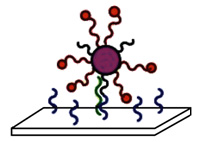化学学报 ›› 2009, Vol. 67 ›› Issue (18): 2144-2148. 上一篇 下一篇
研究论文
包 华a,b 贾春平*,b 周忠良a 金庆辉b 赵建龙b
Bao, Hua a,b Jia, Chunping *,b Zhou, Zhongliang a Jin, Qinghui b Zhao, Jianlong b

运用荧光纳米金探针和基因芯片杂交建立一种新的DNA检测方法. 荧光纳米金探针表面标记有两种DNA探针: 一种为带有Cy5荧光分子的信号探针BP1, 起信号放大作用; 另一种为与靶DNA一部分互补的检测探针P532, 两种探针比例为5∶1. 当靶DNA存在时, 芯片上捕捉探针(与靶DNA的另一部分互补)通过碱基互补配对结合靶DNA, 将靶DNA固定于芯片上; 荧光纳米金探针通过检测探针与靶DNA及芯片结合, 在芯片上形成“三明治”复合结构, 最后通过检测信号探针上荧光分子的信号强度来确定靶DNA的量. 新方法检测灵敏度高, 可以检测浓度为1 pmol/L的靶DNA, 操作简单, 检测时间短. 通过改进纳米金探针的标记和优化杂交条件, 可进一步提高核酸检测的灵敏度, 这将在核酸检测方面具有重要的应用价值.